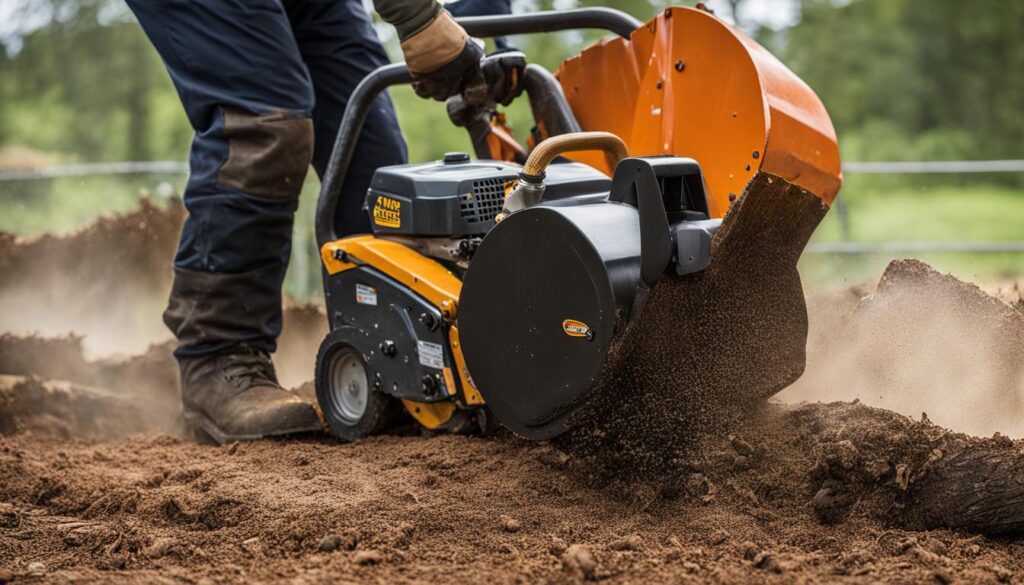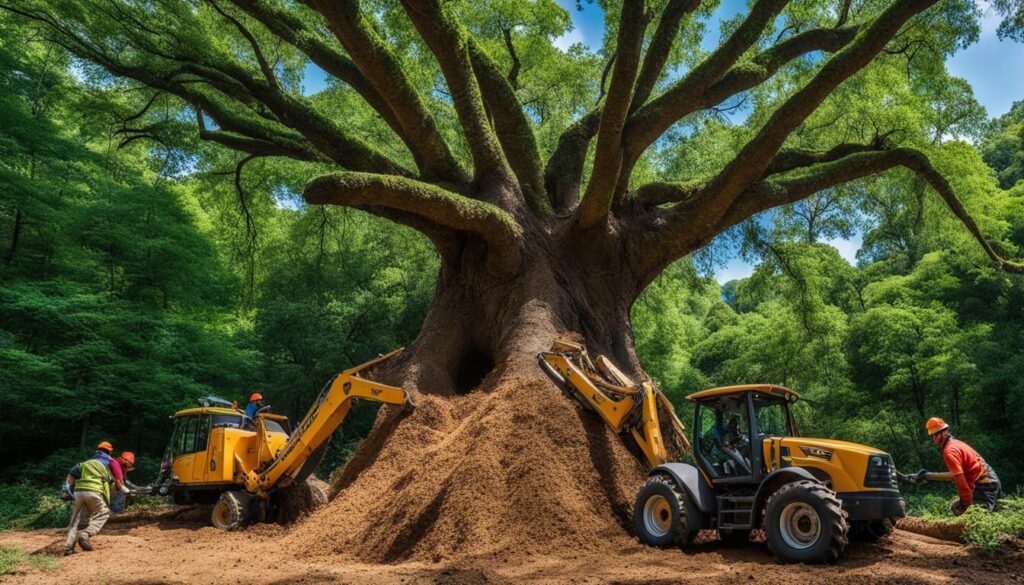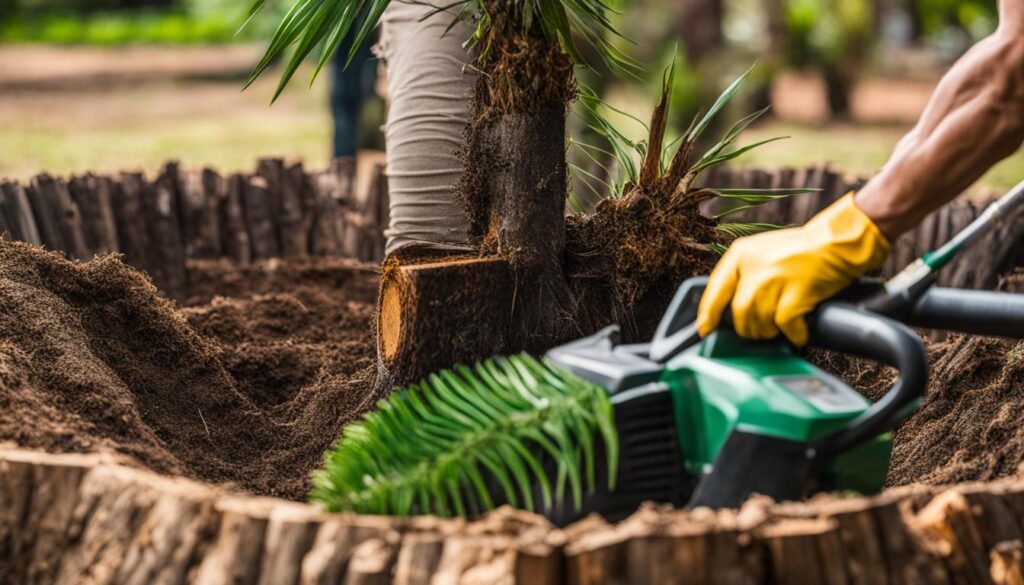When tasked with transforming a landscape, I often encounter remnants of the past—old tree stumps that require removal. Utilizing a grinder for tree stumps has become my go-to approach, melding efficacy with precision. In this guide, my focus is to impart knowledge on tree stump grinding and the stump removal techniques that I’ve honed over the years. Safety always takes precedence in these endeavors. Whether you’re a seasoned professional or new to safe stump grinding, my aim is to provide insights that will ensure efficiency without compromising on safety.
Key Takeaways
- Understanding the mechanics of a tree grinder is crucial for safe stump grinding.
- A grinder for tree stumps must be operated with safety gear and after a thorough site evaluation.
- Tree stump grinding can be a DIY task, but knowing when to call in professionals is key.
- Effective stump removal techniques ensure a cleaner and safer landscape post-grinding.
- Following a systematic approach on how to stump grind reduces potential hazards.
- Maintaining the equipment is necessary to perform consistent and safe tree stump grinding.
Understanding the Stump Grinding Process
When confronting the challenge of removing a tree stump from a property, stump grinders are the equipment of choice for both professionals and dedicated DIY-ers. Let’s delve deeper into the mechanics of these powerful machines and the best practices involved in their operation.
What is a Stump Grinder?
A stump grinder is an indomitable machine designed to tackle the problem of tree stump removal. This piece of stump grinding equipment isn’t simply an ordinary tool; it’s a specialized behemoth built to reduce a stump to sawdust with efficiency and precision. A stump grinder works by employing a high-speed rotating cutting disk outfitted with strong carbide tips. These tips gnaw through the wood, converting what was once a solid tree stump into manageable wood chips.
The Mechanism of Stump Grinders
The heart of a stump grinder’s capability lies in its mechanism. The cutter disk acts like a subterranean buzzsaw, diving deep into the stump and cleaving through the fibrous, resilient wood with the ease of a hot knife through butter. My experience has taught me precision is crucial; thus, each movement by the operator needs to be calculated and deliberate, ensuring that the equipment does the job thoroughly and safely. Stump grinding techniques vary, but commonly, a methodical sweeping motion will ensure that the entire stump is ground down and the area is left well-leveled and neat.
Despite their robust nature, stump grinders are equipped with numerous safety features intended to protect both the user and the immediate environment from harm. Even so, I always emphasize the critical importance of donning protective gear, maintaining a safe operational distance, and conducting regular equipment checks before, during, and after the stump grinding process. By adhering to these guidelines, the task of stump removal becomes not only successful but also safe.
The Necessity of Removing Tree Stumps
As I delve into the world of landscaping and property maintenance, I’ve learned that the process of stump removal isn’t just a cosmetic choice—it’s a crucial step in preserving the safety and health of an outdoor space. Picture an old tree stump: it’s not simply an unsightly reminder of a once-majestic tree, but rather, a hidden menace lurking in your yard. Over time, these stumps can become host to invasive pests or diseases, putting nearby flora at risk.
In my professional stance, opting for stump grinding carries an array of benefits that far exceed simple aesthetics. A tree stump can present itself as a formidable tripping hazard, imperiling both children at play and adults working around the yard. It can obstruct otherwise seamless garden designs and impede planned construction or landscaping upgrades. Thus, tree stump grinding not only clears the way for a pristine lawn but safeguards the underlying ecosystem.
Furthermore, abandoned stumps offer the perfect breeding ground for termites, ants, and other wood-boring pests that can leapfrog to healthy trees, causing more widespread arboreal casualties. By employing effective stump removal methods, not only do I enhance the visual appeal of the property, but I also uphold its integrity against these invasive species.
Moreover, a removed stump clears the path for new plantings, allowing homeowners to reimagine their outdoor spaces with new trees or garden features. It’s this fusion of function and form that elevates stump grinding from a mere task to an essential investment in the betterment of one’s living environment.
How to Stump Grind: A Step-by-Step Approach
Grinding down a tree stump on my own always seemed daunting, but with careful planning and the right tips, I found it to be a rewarding DIY project. In my experience, the first critical step in tree stump grinding is assessing the area around the stump. Ensuring there are no objects, debris, or underground utilities nearby is essential to maintain safety. I always start by trimming the stump as close to the ground as possible to make the process smoother. Positioning the grinder so that it’s directly over the stump is the proper way to begin.
Once everything is set, I start the grinder and carefully lower the wheel onto the stump. It’s important to proceed slowly and use controlled, side-to-side sweeping motions—this is one of the key stump grinding tips for effective results. I keep at it until the stump is ground down to wood chips. Afterward, removing the wood chips and debris from the site is necessary before backfilling the hole with soil to leave a clean and level ground.
Compared to professional services, do-it-yourself stump grinding can be cost-effective and deeply satisfying. However, it’s crucial not to rush the process. Taking my time to do it right ensures that I grind the stump down efficiently, safeguard my property, and feel a sense of accomplishment when I look at the space that is now ready for new possibilities.
Beyond Aesthetics: Safety and Environmental Benefits
When I consider the process of tree stump grinding, my focus tends not only towards enhancing a property’s visual appeal but equally towards upholding rigorous safe stump grinding protocols. These standards are fundamental not just for the immediate physical safety, but they play a significant role in preserving our environment.
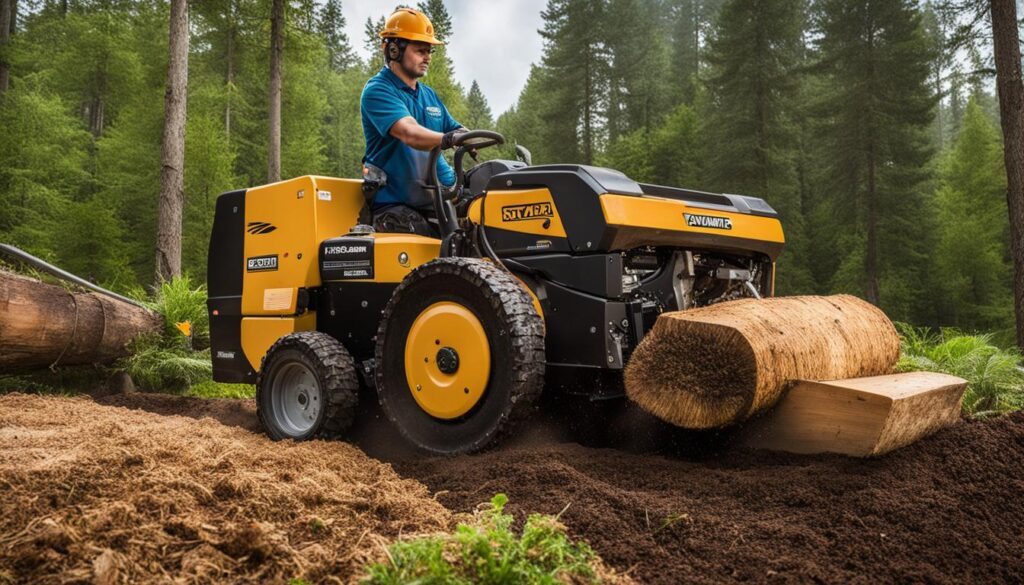

By engaging in best stump grinding practices, I play an active part in removing potential tripping hazards, substantially reducing the risk of accidents on residential and commercial properties. Moreover, the clearing of old stumps deters pest infestations – think of the satisfaction in outsmarting those pesky carpenter ants and termites from making a home near your premises!
Beyond these immediate benefits, my commitment to eco-friendly techniques in professional stump grinding services extends to the well-being of our surroundings. Such practices involve reducing sediment runoff, which in turn, enhances water quality. I also take pride in contributing to the protection of local wildlife habitats by eliminating potential fire hazards that dry stumps can present during hot and dry seasons.
The post-grinding phase is equally critical – responsibly disposing or repurposing the residual wood chips from the grinding process minimizes the environmental impact. This creates a sustainable loop that not only tidies up the landscape but also nourishes it for future growth. Hence, stump grinding transcends mere appearance; it embodies a holistic approach to safety and environmental stewardship.
Selecting the Right Stump Grinding Service
When it comes to maintaining the aesthetic and safety of your property, removing tree stumps is an imperative task that often requires professional intervention. I’m here to guide you through the selection process for finding professional stump grinding services that ensure both efficiency and cost-effectiveness. Not all service providers are created equal, and the key to a satisfactory outcome lies in meticulous evaluation of several crucial factors.
Evaluating Experience and Certifications
The expertise of a stump grinding service is paramount. I look for companies with a solid track record and necessary certifications. These qualifications indicate a provider’s commitment to following industry standards and regulations. Additionally, experience in dealing with various stump grinding scenarios equips professionals to navigate unexpected challenges that may arise during the process. Hence, ensuring that the team is well-versed in the safety and technical intricacies of professional stump grinding is a top priority for me.
Assessing Equipment and Techniques
State-of-the-art equipment is the backbone of efficient stump grinding. I ensure that the service I choose uses the latest machinery that not only expedites the process but also minimizes any potential damage to the surrounding landscape. Moreover, seasoned professionals with access to robust tools are more likely to provide accurate estimates of stump grinding costs, preventing any unwelcome financial surprises. After all, the right equipment and advanced techniques make all the difference.
Considering Customer Feedback and Reputation
Finally, I pay close attention to what other customers are saying. Positive reviews and a strong reputation in the community are indicators of a reliable stump grinding service. I believe that these testimonials reflect the quality of service provided and can be instrumental in making an informed decision. Companies proud of their workmanship will have no shortage of clients vouching for their services. I also keep an eye out for feedback on their response to issues, punctuality, and professionalism.
Searching for ‘stump grinding near me’ can yield numerous options, but it’s essential to compare and consider the professional stump grinding services based on their experience, equipment, and reputation. And while the stump grinding cost is an important factor, it should not be the sole determinant of your choice. Investing in a service that values these criteria ensures a safe and satisfactory stump removal experience on your property.
Preparation for Stump Grinding: A Checklist
Whenever I set out to complete a stump grinding project, I’ve learned that meticulous preparation is just as critical as the grinding itself. Ensuring a successful and injury-free outcome hinges on a series of preemptive actions. Let me share some invaluable stump grinding tips that I apply before the start of every project.
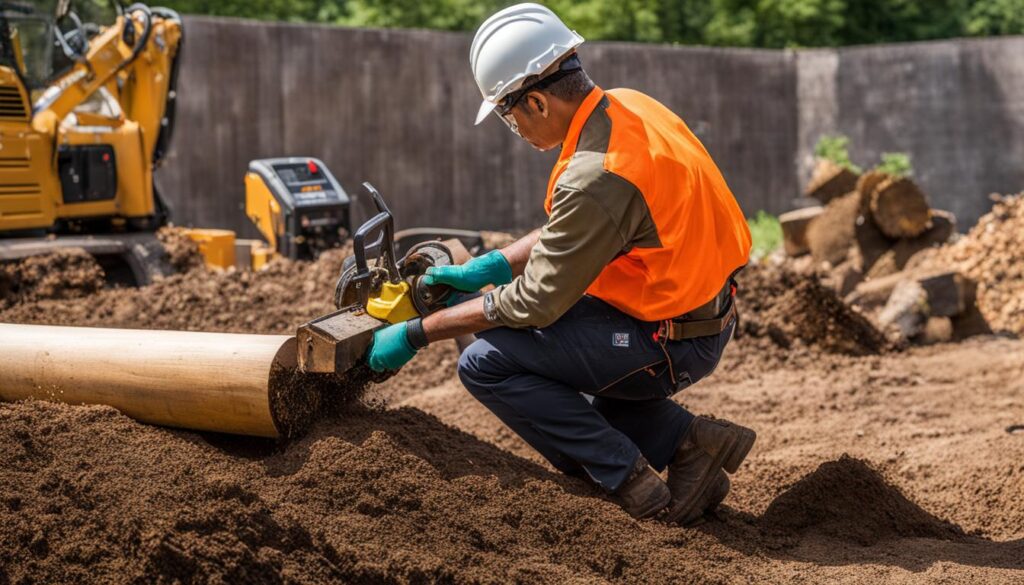

Site Inspection and Safety Precautions
Prior to initiating the stump grinding process, a thorough site inspection is imperative. As a professional stump grinding enthusiast, I meticulously survey the area for hidden obstacles such as rocks, debris, and especially, any underground utilities that can pose threats to both safety and equipment. Clearing these impediments is a non-negotiable step in my routine, ensuring that when I commence with the operation, there’s an unobstructed, safe environment that adheres to safe stump grinding practices.
Personal Protective Equipment (PPE)
I never overlook the importance of donning the necessary personal protective equipment (PPE). High-quality gloves, impact-resistant goggles, ear protection, and sturdy boots form the cornerstone of my gear. In addition, I make it a point to wear chainsaw safety pants to protect against flying debris. This comprehensive approach to PPE is a hallmark of professional stump grinding and is a protocol I recommend for anyone interested in do-it-yourself stump grinding as well. Safety is paramount, and proper PPE is a key component in preventing accidents.
The Technical Side: Operating a Stump Grinder
When I approach the task of how to stump grind, I know that an understanding of how a stump grinder works is crucial. Before powering up the machine, I meticulously position the stump grinding equipment so that the grinder wheel hovers just above the target area. The real action begins as I gradually lower the wheel into the stump, which starts chipping away at the stubborn wood.
Moving the wheel from side to side with the adjustment lever is essential. This side-to-side movement ensures thorough removal, digging into the wood and turning it into manageable chips. Mastery of the lever is akin to an art — it requires finesse and a steady pace. For those embarking on a DIY stump grinding project, remember, patience is key—you may have to pass over the stump multiple times to fully grind it down to the desired depth.
Once the job is done, the right protocol is to switch off the equipment and safely move it away. Speed and force can be the arch-nemesis in stump grinding; too much of either and you risk harming both the equipment and possibly yourself. My advice, honed from experience, is to respect the machinery’s limits and to operate with a steady, methodical approach.
Cost Considerations for Stump Removal
When I assess the financial implications of a stump removal task, I consider various factors that impact the final cost. My experience has taught me that the size and location of the stump are often the principal determinants in the pricing structure. I’ve come to understand that each stump grinding project presents unique challenges and, therefore, customized quoting is essential. As a result, I diligently review each aspect of the potential job before establishing a price point.
Estimating Expenses Based on Stump Size and Location
Precisely calculating stump grinding costs requires a careful consideration of the specific characteristics of each stump. For instance, smaller stumps generally cost less to grind than larger ones due to the reduced amount of work and resources needed. However, the accessibility of the stump plays a critical role in this equation. Stumps that are next to patios, driveways, or fences may necessitate special care, additional time, and consequently, incur higher charges. In such scenarios, the added complexity affects both the stump grinding service procedures and the safety measures undertaken.
Navigating Quotes and Services
To ensure that I am making an informed decision, I advocate for obtaining multiple quotes from professional stump grinding services. This practice allows me to compare not only the stump removal costs but also the expertise and service quality each company brings to the table. Price alone should not be the deciding factor; I place significant value on the reputation and safety protocols of the service provider. This diligence promises a more efficient and secure completion of the stump grinding process, aligning with my commitment to achieve exceptional results while maintaining the integrity of the surrounding area.
FAQ
How do I safely grind a tree stump?
To safely grind a tree stump, ensure that you have the appropriate personal protective equipment (PPE), clear the area of any debris or potential hazards, and use the stump grinder according to the manufacturer’s instructions, moving the machine side-to-side to effectively grind down the stump. Always follow best stump grinding practices for safety and efficiency.
What is a stump grinder?
A stump grinder is a specialized piece of equipment designed to remove tree stumps by grinding them into wood chips. It features a rotating cutting disc with carbide tips that chip away the wood, and it is operated by a trained user to ensure effective and safe stump removal.
How does a stump grinder work?
A stump grinder works by using a high-speed rotating cutting disk with carbide tips that grind the stump and roots into small chips. The machine is operated with controls that allow it to move side to side and lower the cutting wheel into the stump to chip away at it systematically.
Why is stump removal necessary?
Stump removal eliminates potential hazards like tripping, prevents pest infestations, and stops the spread of tree diseases. It also enhances the aesthetics of a property and increases its value by providing a clear area for new planting or other landscaping and construction projects.
What are the steps for grinding down a tree stump?
Grinding down a tree stump involves a step-by-step process including site inspection, clearing hazards, trimming the stump lower to the ground if necessary, positioning the grinder over the stump, and methodically moving it side-to-side to grind the stump into chips. The area is then cleaned, and the ground can be backfilled.
What safety and environmental benefits does stump grinding provide?
Stump grinding promotes a safe environment by removing tripping hazards and potential sources of pest infestations or tree diseases. Environmentally, it prevents sediment runoff contributing to better water quality, protects wildlife habitats, and minimizes fire risks. Utilizing or properly disposing of wood chips also lessens environmental impact.
How do I choose a professional stump grinding service?
Choose a professional stump grinding service by evaluating the company’s certifications, experience, the condition of their equipment, and their adherence to safety standards. Check customer reviews and ask about insurance coverage. Ensure they use proper stump grinding techniques and equipment.
What precautions should I take before stump grinding?
Before stump grinding, conduct a thorough site inspection to identify potential hazards, clear the area of debris, wear the necessary PPE, ensure the safety of bystanders by establishing a perimeter, and prepare the stump for grinding by trimming it as close to the ground as possible.
What personal protective equipment is necessary for stump grinding?
The necessary personal protective equipment for stump grinding includes protective glasses, ear protection, heavy-duty gloves, safety boots, and chainsaw safety pants. Wearing the appropriate PPE is essential for the operator’s safety and for anyone nearby.
What technical aspects should I know when operating a stump grinder?
When operating a stump grinder, you should be aware of how to properly start and maneuver the machine, the process for systematically lowering the cutting wheel into the stump, and how to grind the stump using a side-to-side sweeping motion. Avoid pushing the machine too hard or fast to prevent accidents or damage.
How is the cost of stump grinding determined?
The cost of stump grinding is determined by factors like the size of the stump, the type of tree, and location accessibility. Larger stumps and those in difficult-to-reach areas typically cost more to remove. Obtaining quotes from multiple service providers can help you compare prices and determine the best option for your needs.
What should I look for in quotes and services when considering stump removal?
When considering quotes and services for stump removal, look for transparency in pricing, details about the scope of work, the qualifications of the service provider, the quality of their equipment, and the availability of stump removal methods to suit your specific situation. Compare offerings and prioritize services with good safety records and customer reviews.

